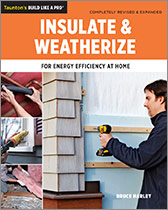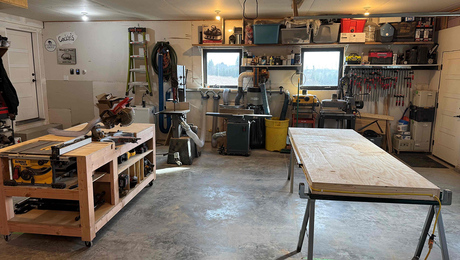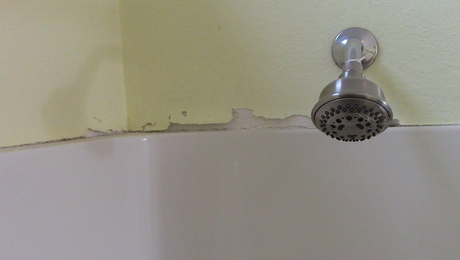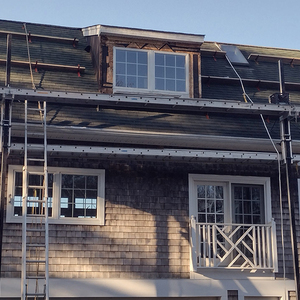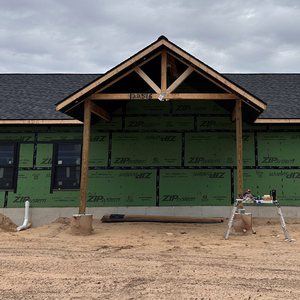Podcast 412: Rotted Walls, Saving Energy, and Let-In Bracing
Colin, Mark, and Patrick hear from listeners about reclaimed local lumber and Type O mortar before taking questions about fixing a wall behind poured concrete, energy improvements for an Atlanta home, and the carbon emissions of Portland cement.
Follow the Fine Homebuilding Podcast on your favorite app. Subscribe now and don’t miss an episode:
 |
 |
Help us make better episodes and enter for a chance to win an FHB Podcast T-shirt:
www.finehomebuilding.com/podcastsurvey
Jonathan tells us about his town’s lumber sale. Alex shares his masonry experience. Andrew needs help fixing part of an exterior wall behind a slab. Sean asks about improving a house with a vented attic with ductwork. Nick wants to know more about let-in bracing. Cole is curious about masonry products with lime instead of Portland cement.
Editor Updates:
- Mark’s house
- Colin’s house
- Jeff’s deck
- Patrick’s stairs
 |
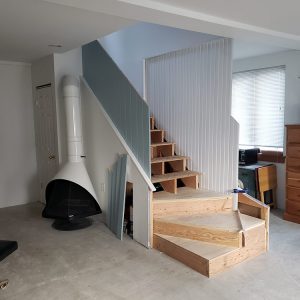 |
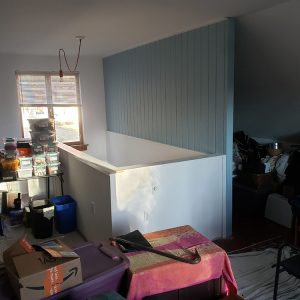 |
Listener Feedback 1:
Jonathan from Silver Spring, MD writes: As you’ve noted in the past, lumber prices are high. Perhaps this was a factor for my local parks department to begin offering lumber for sale. The lumber comes exclusively from local park land. Instead of felling dangerous trees and leaving them to rot, Montgomery Parks is now milling select trees (already slated for removal). Some buddies and I got nice slabs of air dried oak, ash, and maple. Mulberry, cherry, and black walnut slabs were also for sale at good prices. The workers could tell you where each slab came from and the money generated goes right back into maintaining our park land and open spaces.
They said this first ever lumber sale was so successful they will do it again in six months. Lumber was local before it was cool to be local.
 |
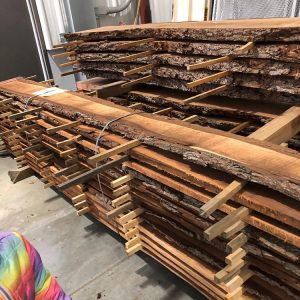 |
 |
Related Link:
Listener Feedback 2:
Alex in Winona, MN writes: After listening to your discussion on lime mortars I think you may have overlooked some important advantages to Type “O” mortar. Although it does have portland a significant portion by volume is lime. It is a very soft mortar (350 psi) and as a rule of thumb the pointing mortar should be softer than the material it surrounds. It cures in a predictable manner and because of the portland has some resistant to freeze thaw (interesting article: Improvements to Water, Salt-Scaling and Freeze-Thaw Resistances of Historic Mortar Replication Mixes).
The interesting lime mortars are NHL (Naturally Hydraulic) which have some impurities that allow it to cure with water (I think the limeworks guys can explain all this). These NHL mortars have rating such as 2,3, etc, some of the higher ratings have compressive strengths that far exceed type “O” 350 psi and can be used for structural applications with the permeability, flexibility the higher portland mortars don’t offer.
All this being said, Type “O” mortar can be made from materials you can purchase in any hardware store. You don’t have to come back in 3 days to joint the work, you don’t have to continually wet it, be fearful of a freezing night a month after you do the work. After working on countless projects where portland/sand mixes and other hard mortar were used- I can only wish that type “O” mortar had been used on these projects. I think you will find Type “O” Mortar is what’s used by most restoration companies and it’s a good first step.
Question 1: How do I feel the gap between my concrete porch and the wood sheathing?
Andrew writes: Hello FHB podcast, I am a new listener and subscriber to the magazine, though I wish I had discovered you months ago. My wife and I bought a 90 0sq.ft. house in Olympia, WA, that was built 100 years ago. We went into it thinking that is would be a small fixer upper, but it has turned into a HUGE project. It turns out that this house has had significant water damage due to a failure in the siding, and moisture/wood destroying insect damage in the sill plate, floor joists, etc. We’ve taken everything down to studs, completely updated the wiring (there was still some knob-and-tube), updated the plumbing, sistered in new floor joists, replaced the sill plate on half of the house, as well as put in mini splits.
Currently, I am in the process of siding the house. When it was built, it had ship-lap sheeting with cedar shingle on top. At some point, a previous owner installed asbestos tiles over the cedar shingles, which was starting the fail. We carefully removed the asbestos siding, and patched the sheathing where it was required. I plan to install hardi-plank with a rainscreen using 1×3 furring strips.
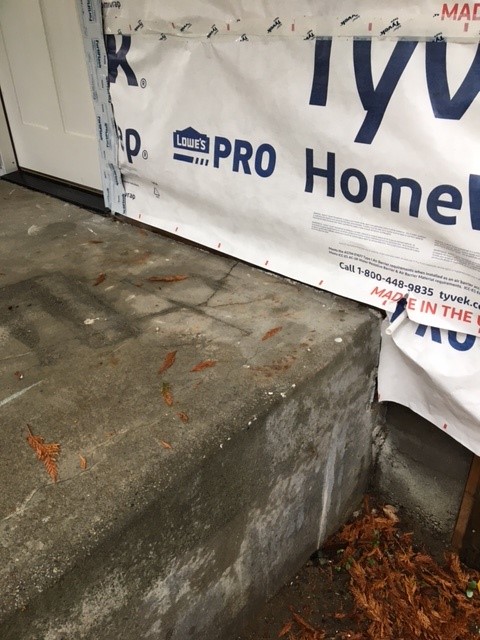 |
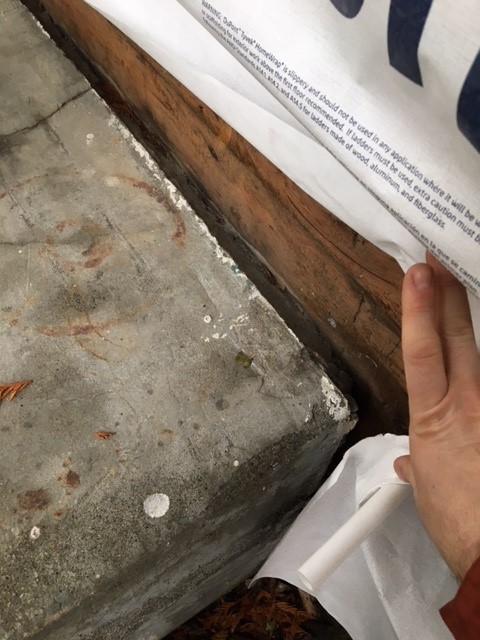 |
 |
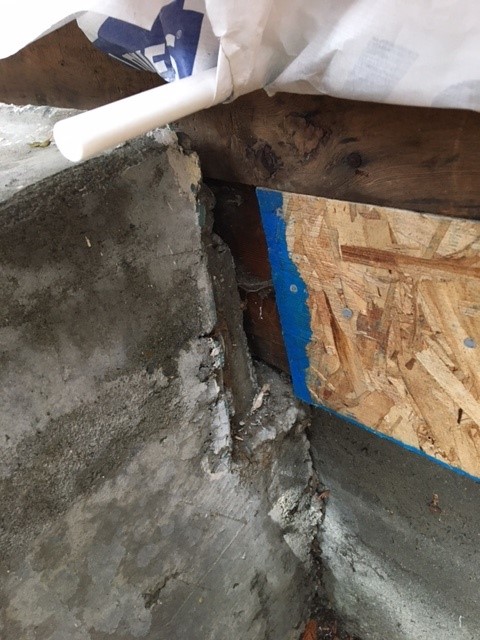 |
Where I am having an issue is at the front porch. The house has a covered front porch that is made of concrete. The concrete was added after the asbestos siding was installed, because the concrete was poured right up over the siding. Now that I have removed the siding there is gap about an inch wide but in inch deep that sits right at the wood sheathing. My worry is that driving rain will find its way back there and cause more wood damage. How do I fill in this trench and effectively keep water from getting back in there? My neighbor suggested filling it with an exterior foam, painting it with Red Gard. I have also considered putting some metal flashing against the sheathing and filling the gap with hand mixed concrete. Any advice would be highly appreciated. Thanks for all your wisdom and advice. P.S. the Project Guide for siding and trim has been a really great resource for me on this project.
Related Links:
- Handling Asbestos Tile
- How to Safely Pour Concrete Against Siding
- Guide to Building (or Rebuilding) Porches
Question 2: Is it too risky to convert a vented attic to an unvented attic in my Atlanta home?
Sean writes: Hi FHB Podcast, My wife and I are looking to purchase our first home in Metro-Atlanta in the coming months—2021 IECC Zone 3A (warm humid). The homes in the areas we are looking are 1970s-1990s, skewing towards the older, slab on grade homes. Aside from bulk water issues the houses might have, the first thing I want to address is air sealing. I plan on getting an independent energy audit within the first few months. One thing I would love to do soon as soon as possible is address the vented attic that will surely be in the home.
My questions are – Is it risky to convert a vented attic to an unvented attic in this age home and generally? Is the better approach to seal the top plates and attic penetrations then add more blown in/fiberglass insulation on top? This would likely accomplish my insulation and air sealing concerns with the attic, but it leaves all the mechanical equipment and HVAC ducts susceptible to the extreme attic conditions.
I’ve already identified several independent energy auditors and insulation companies, but any information or advice the FHB Podcast team can provide would be greatly appreciated.
Related Links:
Question 3: With current material prices being higher and even more so last year, is let-in bracing being considered more?
Nick writes: Patrick, First, let me say that I love the podcast and resources Fine Homebuilding provides. I can’t wait to watch the podcast each week when it is posted on YouTube. Yes, that is right. I am one of those who actually enjoys watching everyone’s faces.
I am currently doing planning and research for an upcoming renovation and home addition that my wife and I have been planning for years. We thought of just selling and buying something else to fit our family but that sweat labor has doubled in value over the last year with these crazy home prices! I am a penny pincher by nature and have been researching how best to approach sheathing, air sealing and insulation.
While looking over exterior insulation I came across a Martin Holladay article (Issue 220) about let-in bracing. I am familiar with let-in bracing being used in older homes but never really thought of it in modern construction which leads to my question. With current material prices being higher and even more so last year, is let-in bracing being considered more? It seems that either using exterior foam sheathing with OSB only in the corners or 1×4 bracing could be a decent way to save some money and also decreases concerns of moisture accumulating on OSB that would normally be sandwiched between exterior and interior foam. Was curious what your thoughts on this were.
P.S. Thank you to everyone who participates in the podcast! I have worked in websites/media for many years and can appreciate the hard work that it takes to put them together.
Related Links:
Question 4: I’d love to hear more about modern usage of Lime mortar which is actually carbon negative, and Limecrete and Sand Lime bricks in eco-friendly homebuilding.
Cole from YouTube writes: A lot of people don’t realize that 8% of all global carbon emissions come from concrete, specifically the Portland Cement component (.9lbs of co2 per 1lb of cement). I’d love to hear more about modern usage of Lime mortar which is actually carbon negative, and Limecrete and Sand Lime bricks in eco-friendly homebuilding. I know these are more common in Europe, possibly because of all the historical buildings. The knowledge is centuries if not millennia old, but it seems we’ve abandoned it for the convenience of Portland Cement even when we don’t need its strength advantages.
Related Links:
End Note:
Check out our latest Project Guide: Siding & Exterior Trim!
Check out our FHB Houses:
Visit the Taunton Store • Magazine Index • Online Archive • Our First Issues • All Access
Help us make better episodes and enter for a chance to win an FHB Podcast T-shirt: www.finehomebuilding.com/podcastsurvey

If you have any questions you would like us to dig into for a future show, shoot an email our way: [email protected].
If we use your question we’ll send you a FHB Podcast sticker!
FHB Podcast T-shirts!
Represent your favorite podcast! Available in several styles and colors. Made from 100% cotton. Find the Podcast t-shirt and more cool products in the Fine Homebuilding Store.
Fine Homebuilding podcast listeners can now get 20% off anything in the Taunton store, including Insulate & Weatherize.
Use the discount code FHBPODCAST to take advantage of this special offer.
We hope you will take advantage of a great offer for our podcast listeners: A special 20% off the discounted rate to subscribe to the Fine Homebuilding print magazine. That link goes to finehomebuilding.com/podoffer.
The show is driven by our listeners, so please subscribe and rate us on iTunes or Google Play, and if you have any questions you would like us to dig into for a future show, shoot an email our way: [email protected]. Also, be sure to follow Fine Homebuilding on Instagram, and “like” us on Facebook. Note that you can watch the show above, or on YouTube at the Fine Homebuilding YouTube Channel.
The Fine Homebuilding Podcast embodies Fine Homebuilding magazine’s commitment to the preservation of craftsmanship and the advancement of home performance in residential construction. The show is an informal but vigorous conversation about the techniques and principles that allow listeners to master their design and building challenges.
Other related links
-
- All FHB podcast show notes: FineHomebuilding.com/podcast.
- #KeepCraftAlive T-shirts and hats support scholarships for building trades students. So order some gear at KeepCraftAlive.org.
- The direct link to the online store is here.






